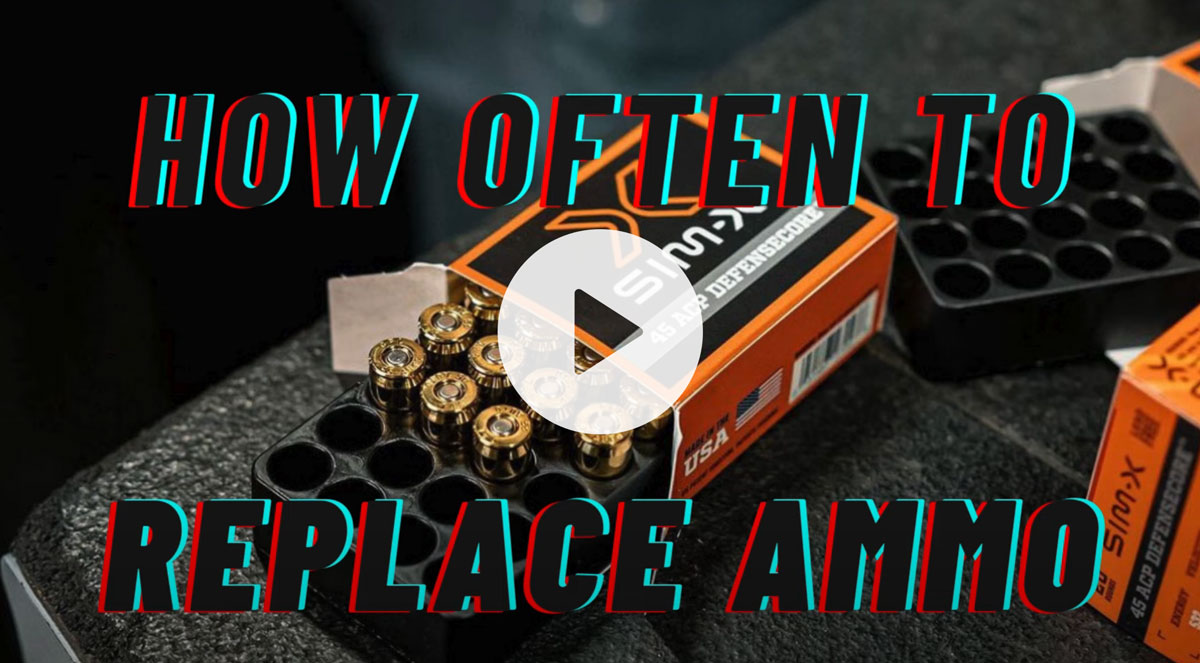As you become more comfortable carrying a pistol for self-defense, you learn a lot—and you learn all sorts of things. For instance, you learn about the defensive ammunition you use and carry. Surprisingly, there is a high amount of wear and tear that occurs when you carry on a regular basis. You learn about the detrimental effects of repeated loading, excessive oil and moisture, to name a few. Eventually, you realize you need to come up with a system. Some type of system for inspecting and when necessary, replacing your defensive ammunition, despite the cost.
Here are five tips when it comes to your caring, inspecting and replacing defensive ammunition:
- How often do you carry
- How to inspect ammo
- Avoid unnecessary damage
- Create a rotation system
- Storage and preventative maintenance
At times it can feel like you are drinking from a firehose in the beginning. With time you pick up more and more. Don’t feel like you must be all-knowing all at once. Focus on important subjects for newer shooters, such as safety and marksmanship. You will discover other subjects naturally, still others will take some work. How often you replace your defensive ammunition is not something you think about in the beginning. In fact, you may still be on the fence about carrying premium defensive ammunition. Regardless, they have a shelf life of useable service. Somethings we can accelerate the end of useable service, while others can extend the useable service.
What Is the Frequency of Carry

Visually Inspect Ammunition for Service
You don’t need an intimate knowledge of ammunition manufacturing to inspect your loadout. A good deal of common sense and observational skills come in handy. The ammunition inspection starts the moment you open the box. Separate the tray from the box and set it on a flat surface. Step back and look at the primers. They should all look uniform in nature; look for anything that stands out. Remove the quantity necessary to load your carry magazine. Place them on a flat surface in a line, all touching one another. Take a step back and look for uniform height or anything that stands out. Lastly, look at each round individually for any imperfections or damage as you load them into your magazine. These steps alone can significantly reduce the chance of introducing a manufacture defect that escaped quality control. Once you’ve been carrying the ammunition for an extended period you will want to perform this same inspection with two more added steps. The first step has to do with obvious deterioration in color. This can be viewable on the projectile, as well as the casing. If it looks tarnished that’s one thing; if it looks rusted that’s a bad thing. The last step has to do with wiping any excess moisture or oil. Your ammunition should be void of both as often as possible.
Reduce Unnecessary Handling & Getting Wet
The normal functioning of the pistol can be traumatic to the round being chambered or loaded. The recoil spring forcefully scraps the top round from the magazine, then jams it up a feed ramp where it will eventually come to rest in the chamber. This action is performed on every chambered round and not a real concern when immediately fired. It becomes a concern when the same round goes through this cycle several times. The more times this round is chambered and re-chambered, the higher the chance the bullet itself can be shoved deeper into the casing, into what’s called bullet setback. This can at times increase the acceptable chamber pressure to potentially unsafe limits. The more we handle the firearm, combined with the loading and unloading actions, the higher the chance we can make a mistake resulting in a negligent discharge. Limiting this function reduces those negative outcomes—bullet setback and negligent discharge.
Storing a pistol unloaded when not in use is a good idea. However, if the pistol is going to be carried with any degree of frequency, you increase these risks. My recommendation is to reduce the amount of loading and unloading to only what is necessary. If I’m going to dry fire practice, go to the range or clean the pistol, it is not only necessary, but essential for safety that I correctly unload. Moisture—and I mean like getting wet—is also wise to avoid. While most defensive ammunition is waterproof, it is a bad idea to submerse or expose your pistol and ammunition to prolonged exposure of water, rain or snow. This can also include excessive oil or lubrication. Too much oil can penetrate the primer pockets and jeopardize their functioning. If you get drenched while running through a rainstorm or accidentally fall into a body of water, it is not the end of the world, but prolonged exposure is what we are talking about.
Simple & Effective Rotation System
At a certain point, creating a system to replace defensive ammunition, when necessary, is smart. If you are inspecting and replacing damaged rounds regularly and you follow all other guidelines, you will maximize their service life. I inspect and replace all my carry ammunition once a year and my home defense ammunition about every three years. When I unload a live round, I mark this round to denote it has been ejected. After I safely retrieve the live round, I take a permanent marker and put a tick mark on the bottom of the casing, but not over the primer. Every time I unload a round it gets a tick mark. When I do my yearly inspections, I set aside all rounds that have these tick marks. My rule of thumb is three tick marks and the round is for practice only. I download the magazine’s five to seven live rounds and load the marked round followed by the remaining unmarked live rounds. This is a good compromise of cost versus usage to help increase the longevity of my defensive ammunition.
Increased Storage Safety & Easy Maintenance
When it comes to storing firearms, everyone will need to make some personal choices. These decisions take into consideration your comfort level, your household and applicable laws. If you have young children or other family and friends, denying access is essential. Storing a loaded pistol in your safe or gun locker is a personal choice. My suggestion is to stow the loaded pistol inserted into the holster. This accomplishes two things; protects the trigger and reduces unnecessary handling. For the pistol to discharge, the trigger must be moved to the rear. A well-designed holster will protect the trigger while securely holstered. My practice is to remove the holster and pistol as one unit, a monolithic unit. So, placing the monolithic unit in your safe makes it easier and safer. When I get ready to leave my home or when needed, I grab the unit and safely secure it to my body. A common culprit when rounds fail to fire has to do with a faulty primer. This can be due to manufacture errors, but it can also be due to excessive oil. When you clean and re-oil your pistol, do it, but be sparing with the oil. Remember, oil will attract all the other foreign objects and debris discussed earlier. A light coat on the high wear or metal-to-metal areas will do the job. I’ve gotten in the habit of a regular wipe down and re-oiling. When I take my carry gun to the range for practice, I unload and mark the ejected round as discussed. At the end of my range session and before loading my defensive ammunition, I do a little preventative maintenance. I wipe down the pistol’s exterior, then without disassembling, I apply a light coat of oil to key points. I kill two birds with one stone. In this case, I take advantage of unloading the chambered defensive round.
The more you carry a pistol for self-defense, the more you learn. Using these five tips will help answer the question of when you should replace your defensive ammunition. If you carry often and shoot regularly, you should, at a minimum, inspect your ammunition before you put it into service. Do a quick visual inspection for obvious defects. Look for bad primers or poorly seated rounds. Minimize the unnecessary damage to your loadout where possible. But if you must unload and reload the same rounds, mark them. A home defense pistol may be good for several years in a climate-controlled environment, but your carry pistol needs regular upkeep. Preventative maintenance is a good habit to develop. After unloading and cleaning your pistol, apply only a light coating of oil and wipe the excess with a clean rag. Following these tips will not only extend the service life of your defensive ammunition investment, but it will ensure they have the best of peak performance.

